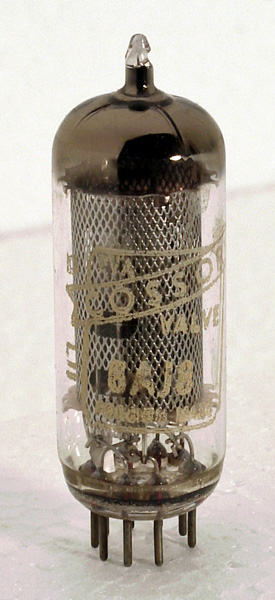|
6AJ8Sensibly equivalent¶ to:
|
|
|

|
The 6AJ8 triode heptode was designed for the role of frequency changer (mixer) in superhet receivers, the two valves share a common cathode. The triode is to be used as the local oscillator feeding the 13 Volts amplitude sine wave to the heptode mixer. Within the heptode, non linear operating causes the signals to interact to produce in the anode waveform the following major frequencies: signal, LO, signal + LO and signal minus LO. The anode circuit is tuned to enhance one of these signals, normally signal minus LO. For radio reception at the time an intermediate frequency of 455 KHz would be typical.This valve dates from after the time that Cossor ceased production of mass market valves. The ridges moulded in the top of the glass envelope suggest that it was made on a Philips-Mullard production line and therefore presumably is an ECH81. Since they could not resell it under a Mullard type number, Cossor have renamed it using the type number of a American equivalent. This would also help to make it saleable in the export market.The thin glass tube envelope is 20 mm in diameter and, excluding the B9A base pins, is 58 mm tall.References: Data-sheet, 3002 & 1040. Type 6AJ8 was first introduced in 1951. See also 1951 adverts. |
Pin Connections
| 1 | 2 | 3 | 4 | 5 | 6 | 7 | 8 | 9 |  g2,g4 | g1 | k,g5,s | h | h | a | g3 | a(t) | g1(t) |
|
|
Absolute Maximum Operating Conditions¶
| Vh | Ah | Va | mAa | 
| 6.3 | 0.3 | 100 | 13 |
|
Absolute Maximum Operating Conditions¶
| Va | Vs | Vg | mAa | mAs | ra | gm | 
| 250 | 250 | -2 | 6.5 | 3.8 | 0.7M | 0.775 |
|
Updated October 12, 2016.
|
|